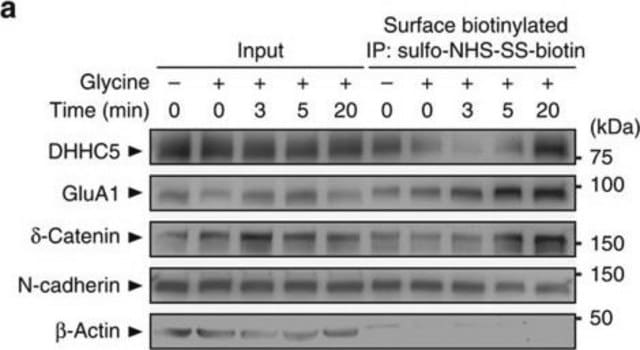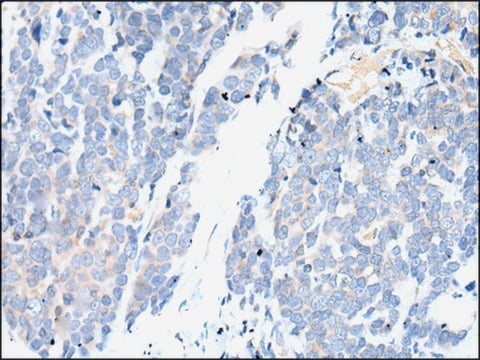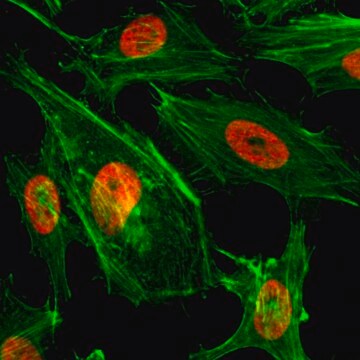07-710
Anti-SMC2/hCAP-E Antibody
serum, Upstate®
Iniciar sesiónpara Ver la Fijación de precios por contrato y de la organización
About This Item
Código UNSPSC:
12352203
eCl@ss:
32160702
NACRES:
NA.41
Productos recomendados
origen biológico
rabbit
Nivel de calidad
forma del anticuerpo
serum
tipo de anticuerpo
primary antibodies
clon
polyclonal
reactividad de especies
human
fabricante / nombre comercial
Upstate®
técnicas
western blot: suitable
Nº de acceso NCBI
Nº de acceso UniProt
Condiciones de envío
dry ice
modificación del objetivo postraduccional
unmodified
Información sobre el gen
human ... SMC2(10592)
Descripción general
SMC2 and SMC4 from the active ATPase subunit of Condensin I and Condensin II complexes that regulate chromosome compaction.
Especificidad
SMC2/hCAP-E
Inmunógeno
KLH-conjugated, synthetic peptide corresponding to amino acids 1184-1197 (C-KSKAKPPKGAHVEV) of human SMC2/hCAP-E (Structural Maintenance of Chromosome 2/ Chromosome-Associated Protein E) with an N-terminal cysteine added for conjugation purposes.
Aplicación
Anti-SMC2/hCAP-E Antibody is a high quality Rabbit Polyclonal Antibody for the detection of SMC2/hCAP-E & has been validated in WB.
Research Category
Epigenetics & Nuclear Function
Epigenetics & Nuclear Function
Research Sub Category
Cell Cycle, DNA Replication & Repair
Cell Cycle, DNA Replication & Repair
Calidad
Routinely evaluated by immunoblot.
Descripción de destino
137kDa
Forma física
Serum
Almacenamiento y estabilidad
2 years at -20°C
Nota de análisis
Control
Positive Antigen Control: Catalog #12-309, Hela cell nuclear extract. Add an equal volume of Laemmli reducing sample buffer to 10 μL of extract and boil for 5 minutes to reduce the preparation. Load 20 μg of reduced extract per lane for minigels.
Positive Antigen Control: Catalog #12-309, Hela cell nuclear extract. Add an equal volume of Laemmli reducing sample buffer to 10 μL of extract and boil for 5 minutes to reduce the preparation. Load 20 μg of reduced extract per lane for minigels.
Información legal
UPSTATE is a registered trademark of Merck KGaA, Darmstadt, Germany
Cláusula de descargo de responsabilidad
Unless otherwise stated in our catalog or other company documentation accompanying the product(s), our products are intended for research use only and are not to be used for any other purpose, which includes but is not limited to, unauthorized commercial uses, in vitro diagnostic uses, ex vivo or in vivo therapeutic uses or any type of consumption or application to humans or animals.
Not finding the right product?
Try our Herramienta de selección de productos.
Código de clase de almacenamiento
10 - Combustible liquids
Clase de riesgo para el agua (WGK)
WGK 1
Certificados de análisis (COA)
Busque Certificados de análisis (COA) introduciendo el número de lote del producto. Los números de lote se encuentran en la etiqueta del producto después de las palabras «Lot» o «Batch»
¿Ya tiene este producto?
Encuentre la documentación para los productos que ha comprado recientemente en la Biblioteca de documentos.
Mingxuan Sun et al.
Chromosome research : an international journal on the molecular, supramolecular and evolutionary aspects of chromosome biology, 26(4), 277-295 (2018-08-26)
During cell division, chromosomes must be folded into their compact mitotic form to ensure their segregation. This process is thought to be largely controlled by the action of condensin SMC protein complexes on chromatin fibers. However, how condensins organize metaphase
Classification, subtype discovery, and prediction of outcome in pediatric acute lymphoblastic leukemia by gene expression profiling.
Yeoh, Eng-Juh, et al.
Cancer Cell, 1, 133-143 (2002)
Alexander Schleiffer et al.
Molecular cell, 11(3), 571-575 (2003-04-02)
We describe a superfamily of eukaryotic and prokaryotic proteins (kleisins) that includes ScpA, Scc1, Rec8, and Barren. Scc1 interacts with SMC proteins through N- and C-terminal domains to form a ring-like structure. Since these are the only domains conserved among
J A Schmiesing et al.
Molecular and cellular biology, 20(18), 6996-7006 (2000-08-25)
Structural maintenance of chromosomes (SMC) family proteins play critical roles in structural changes of chromosomes. Previously, we identified two human SMC family proteins, hCAP-C and hCAP-E, which form a heterodimeric complex (hCAP-C-hCAP-E) in the cell. Based on the sequence conservation
K Kimura et al.
The Journal of biological chemistry, 276(8), 5417-5420 (2001-01-04)
13S condensin is a five-subunit protein complex that plays a central role in mitotic chromosome condensation. The condensin complex was originally identified and purified from Xenopus egg extracts and shown to have an ATP-dependent positive supercoiling activity in vitro. We
Nuestro equipo de científicos tiene experiencia en todas las áreas de investigación: Ciencias de la vida, Ciencia de los materiales, Síntesis química, Cromatografía, Analítica y muchas otras.
Póngase en contacto con el Servicio técnico






